Related Research Articles

A scar is an area of fibrous tissue that replaces normal skin after an injury. Scars result from the biological process of wound repair in the skin, as well as in other organs, and tissues of the body. Thus, scarring is a natural part of the healing process. With the exception of very minor lesions, every wound results in some degree of scarring. An exception to this are animals with complete regeneration, which regrow tissue without scar formation.
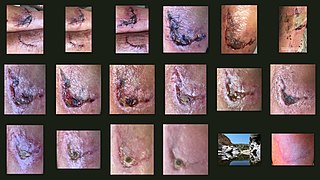
Wound healing refers to a living organism's replacement of destroyed or damaged tissue by newly produced tissue.
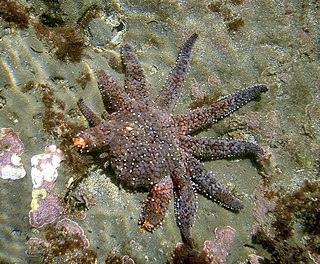
In biology, regeneration is the process of renewal, restoration, and tissue growth that makes genomes, cells, organisms, and ecosystems resilient to natural fluctuations or events that cause disturbance or damage. Every species is capable of regeneration, from bacteria to humans. Regeneration can either be complete where the new tissue is the same as the lost tissue, or incomplete after which the necrotic tissue becomes fibrosis.
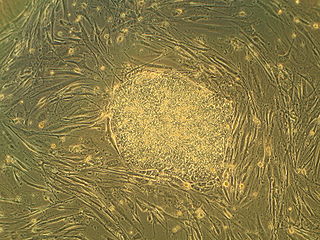
Regenerative medicine deals with the "process of replacing, engineering or regenerating human or animal cells, tissues or organs to restore or establish normal function". This field holds the promise of engineering damaged tissues and organs by stimulating the body's own repair mechanisms to functionally heal previously irreparable tissues or organs.
Stem-cell therapy is the use of stem cells to treat or prevent a disease or condition. As of 2016, the only established therapy using stem cells is hematopoietic stem cell transplantation. This usually takes the form of a bone-marrow transplantation, but the cells can also be derived from umbilical cord blood. Research is underway to develop various sources for stem cells as well as to apply stem-cell treatments for neurodegenerative diseases and conditions such as diabetes and heart disease.

Elaine V. Fuchs is an American cell biologist famous for her work on the biology and molecular mechanisms of mammalian skin and skin diseases, who helped lead the modernization of dermatology. Fuchs pioneered reverse genetics approaches, which assess protein function first and then assess its role in development and disease. In particular, Fuchs researches skin stem cells and their production of hair and skin. She is an investigator at the Howard Hughes Medical Institute and the Rebecca C. Lancefield Professor of Mammalian Cell Biology and Development at The Rockefeller University.
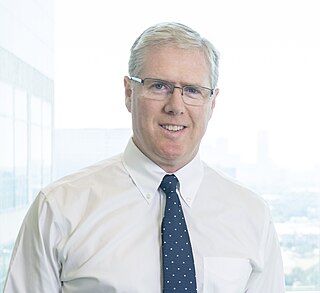
Sean J. Morrison is a Canadian-American stem cell biologist and cancer researcher. Morrison is the director of Children's Medical Center Research Institute at UT Southwestern, a nonprofit research institute established in 2011 as a joint venture between Children’s Health System of Texas and UT Southwestern Medical Center. The CRI was established in 2011 by Morrison with the mission to perform transformative biomedical research at the interface of stem cell biology, cancer, and metabolism to better understand the biological basis of disease. He is a Howard Hughes Medical Institute Investigator and member of the National Academy of Medicine. From 2015 to 2016 Morrison served as the president of the International Society for Stem Cell Research.
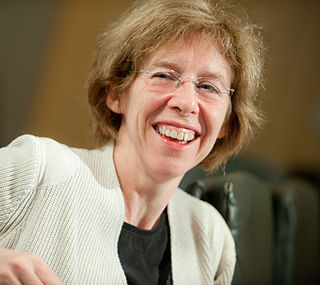
Fiona Watt, is a British scientist who is internationally known for her contributions to the field of stem cell biology. In the 1980s, when the field was in its infancy, she highlighted key characteristics of stem cells and their environment that laid the foundation for much present day research. She is currently director of the Centre for Stem Cells & Regenerative Medicine at King's College London, and Executive Chair of the Medical Research Council (MRC), the first woman to lead the MRC since its foundation in 1913. On 13 July 2021 she was appointed as the new Director of the European Molecular Biology Organization (EMBO).

Janet Rossant, is a developmental biologist well known for her contributions to the understanding of the role of genes in embryo development. She is a world renowned leader in developmental biology. Her current research interests focus on stem cells, molecular genetics, and developmental biology. Specifically, she uses cellular and genetic manipulation techniques to study how genes control both normal and abnormal development of early mouse embryos. Rossant has discovered information on embryo development, how multiple types of stem cells are established, and the mechanisms by which genes control development. In 1998, her work helped lead to the discovery of the trophoblast stem cell, which has assisted in showing how congenital anomalies in the heart, blood vessels, and placenta can occur.
The stem cell theory of aging postulates that the aging process is the result of the inability of various types of stem cells to continue to replenish the tissues of an organism with functional differentiated cells capable of maintaining that tissue's original function. Damage and error accumulation in genetic material is always a problem for systems regardless of the age. The number of stem cells in young people is very much higher than older people and thus creates a better and more efficient replacement mechanism in the young contrary to the old. In other words, aging is not a matter of the increase in damage, but a matter of failure to replace it due to a decreased number of stem cells. Stem cells decrease in number and tend to lose the ability to differentiate into progenies or lymphoid lineages and myeloid lineages.

Helen Margaret Blau is an American biologist and the Donald E. and Delia B. Baxter Foundation Professor and Director of the Baxter Laboratory for Stem Cell Biology at Stanford University School of Medicine. She is known for establishing the reversibility of the mammalian differentiated state. Her landmark papers showed that nuclear reprogramming and the activation of novel programs of gene expression were possible, overturning the prevailing view that the differentiated state was fixed and irreversible. Her discoveries opened the door for cellular reprogramming and its application to stem cell biology.
Amy J. Wagers is the Forst Family Professor of Stem Cell and Regenerative Biology at Harvard University and Harvard Medical School, an investigator in islet cell and regenerative biology at the Joslin Diabetes Center, and principal faculty of the Harvard Stem Cell Institute. She is co-chair of the Department of Stem Cells and Regenerative Biology at Harvard Medical School.
Regeneration in humans is the regrowth of lost tissues or organs in response to injury. This is in contrast to wound healing, or partial regeneration, which involves closing up the injury site with some gradation of scar tissue. Some tissues such as skin, the vas deferens, and large organs including the liver can regrow quite readily, while others have been thought to have little or no capacity for regeneration following an injury.
Valerie Horsley is an American cell and developmental biologist. She currently works as an associate professor at Yale University, where she has extensively researched the growth, restoration, and maintenance of skin cells. She is a currently a member of the Yale Cancer Center and Yale Stem Cell Center. She received a Presidential Early Career Award for Scientists and Engineers in 2012 and in 2013 she was the recipient of the Rosalind Franklin Young Investigator Award.
The stem cell secretome is a collective term for the paracrine soluble factors produced by stem cells and utilized for their inter-cell communication. In addition to inter-cell communication, the paracrine factors are also responsible for tissue development, homeostasis and (re-)generation. The stem cell secretome consists of extracellular vesicles, specifically exosomes, microvesicles, membrane particles, peptides and small proteins (cytokines). The paracrine activity of stem cells, i.e. the stem cell secretome, has been found to be the predominant mechanism by which stem cell-based therapies mediate their effects in degenerative, auto-immune and/or inflammatory diseases. Though not only stem cells possess a secretome which influences their cellular environment, their secretome currently appears to be the most relevant for therapeutic use.
Cédric Blanpain is a Belgian researcher in the field of stem cells. He is a tenured professor of developmental biology and genetics at Université Libre de Bruxelles and director of the stem cell and cancer lab at its Faculty of Medicine. He was one of the first researchers in the world to use cell lineage tracing in cancer research and he showed for the first time the existence of cancer stem cells in solid tumors in vivo. He was selected by Nature as one of 10 People who mattered most in 2012 and he received the outstanding young investigator award of the International Society for Stem Cell Research.
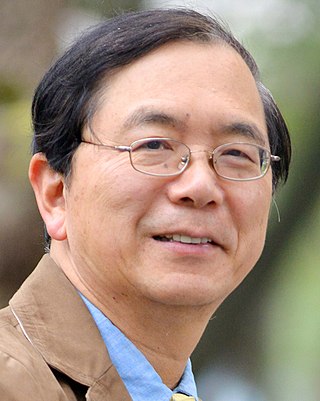
Cheng-Ming Chuong is a Taiwanese-American biomedical scientist.
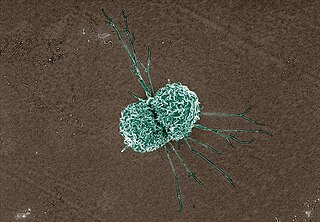
Dermal macrophages are macrophages in the skin that facilitate skin homeostasis by mediating wound repair, hair growth, and salt balance. Their functional role in these processes is the mediator of inflammation. They can acquire an M1 or M2 phenotype to promote or suppress an inflammatory response, thereby influencing other cells' activity via the production of pro-inflammatory or anti-inflammatory cytokines. Dermal macrophages' ability to acquire pro-inflammatory properties also potentiates them in cancer defence. M1 macrophages can suppress tumour growth in the skin by their pro-inflammatory properties. However, M2 macrophages support tumour growth and invasion by the production of Th2 cytokines such as TGFβ and IL-10. Thus, the exact contribution of each phenotype to cancer defence and the skin's homeostasis is still unclear.
Anjali Kusumbe is a British-Indian biologist who is the Head of the Tissue and Tumour Microenvironments Group at the Medical Research Council Human Immunology Unit and Weatherall Institute of Molecular Medicine at the University of Oxford. She was awarded the Royal Microscopical Society Award for Life Sciences in 2022.
Emi K. Nishimura is a Japanese biologist who is Professor of Ageing and Regeneration at the University of Tokyo. Her research considers the molecular mechanisms that underpin ageing. She was elected Fellow of the National Academy of Sciences in 2022.
References
- 1 2 3 Sedwick, Caitlin (2014-11-24). "Valentina Greco: Got hair?". The Journal of Cell Biology. 207 (4): 436–437. doi:10.1083/jcb.2074pi. ISSN 0021-9525. PMC 4242828 . PMID 25422370.
- ↑ Greco, Valentina (November 2016). "The thrill of scientific discovery and leadership with my group". Molecular Biology of the Cell. 27 (21): 3188–3191. doi:10.1091/mbc.E16-06-0373. ISSN 1059-1524. PMC 5170847 . PMID 27799490.
- 1 2 3 4 5 "Valentina Greco, PhD". Yale School of Medicine. Retrieved 2019-10-19.
- 1 2 Greco, Valentina; Chen, Ting; Rendl, Michael; Schober, Markus; Pasolli, H. Amalia; Stokes, Nicole; Cruz-Racelis, June dela; Fuchs, Elaine (2009-02-06). "A Two-Step Mechanism for Stem Cell Activation during Hair Regeneration". Cell Stem Cell. 4 (2): 155–169. doi:10.1016/j.stem.2008.12.009. ISSN 1934-5909. PMC 2668200 . PMID 19200804.
- 1 2 3 "Research". Greco Lab. Retrieved 2019-10-19.
- ↑ Rompolas, Panteleimon; Mesa, Kailin R.; Greco, Valentina (October 2013). "Spatial organization within a niche as a determinant of stem-cell fate". Nature. 502 (7472): 513–518. Bibcode:2013Natur.502..513R. doi:10.1038/nature12602. ISSN 1476-4687. PMC 3895444 . PMID 24097351.
- ↑ Rompolas, Panteleimon; Mesa, Kailin R.; Kawaguchi, Kyogo; Park, Sangbum; Gonzalez, David; Brown, Samara; Boucher, Jonathan; Klein, Allon M.; Greco, Valentina (2016-06-17). "Spatiotemporal coordination of stem cell commitment during epidermal homeostasis". Science. 352 (6292): 1471–1474. Bibcode:2016Sci...352.1471R. doi:10.1126/science.aaf7012. ISSN 0036-8075. PMC 4958018 . PMID 27229141.
- ↑ Park, Sangbum; Gonzalez, David G.; Guirao, Boris; Boucher, Jonathan D.; Cockburn, Katie; Marsh, Edward D.; Mesa, Kailin R.; Brown, Samara; Rompolas, Panteleimon; Haberman, Ann M.; Bellaïche, Yohanns (March 2017). "Tissue-scale coordination of cellular behaviour promotes epidermal wound repair in live mice". Nature Cell Biology. 19 (3): 155–163. doi:10.1038/ncb3472. ISSN 1476-4679. PMC 5581297 . PMID 28248302.
- ↑ Pineda, Cristiana M.; Gonzalez, David G.; Matte-Martone, Catherine; Boucher, Jonathan; Lathrop, Elizabeth; Gallini, Sara; Fons, Nathan R.; Xin, Tianchi; Tai, Karen; Marsh, Edward; Nguyen, Don X. (2019-10-07). "Hair follicle regeneration suppresses Ras-driven oncogenic growth". The Journal of Cell Biology. 218 (10): 3212–3222. doi: 10.1083/jcb.201907178 . ISSN 0021-9525. PMC 6781447 . PMID 31488583.
- ↑ "How Cell Biologists Work: Valentina Greco on cultivating a passionate research team". ASCB. 2017-10-13. Retrieved 2020-11-23.
- ↑ "Dr. Valentina Greco Uncovers the Secrets Behind Skin and Hair Regeneration". New York Stem Cell Foundation. Retrieved 2020-11-23.
- ↑ Velasco, Mary Grace M.; Zhang, Mengyang; Antonello, Jacopo; Yuan, Peng; Allgeyer, Edward S.; May, Dennis; M’Saad, Ons; Kidd, Phylicia; Barentine, Andrew E. S.; Greco, Valentina; Grutzendler, Jaime (2019-10-02). "3D super-resolution deep-tissue imaging in living mice". bioRxiv: 790212. doi: 10.1101/790212 . S2CID 208605520.
- ↑ Kam, Chen Y; Greco, Valentina (2019-10-01). "Lymph vessels find a hairy niche". The EMBO Journal. 38 (19): e103219. doi:10.15252/embj.2019103219. ISSN 0261-4189. PMC 6769378 . PMID 31531872.
- ↑ "Valentina Greco Receives the 2021 ISSCR Momentum Award". medicine.yale.edu. Retrieved 2023-09-09.
- ↑ "Valentina Greco, PhD | 2020 SID Annual Meeting | Speakers". SID Annual Meeting. Retrieved 2020-11-23.
- ↑ "Mentoring | Office for Postdoctoral Affairs". postdocs.yale.edu. Retrieved 2020-11-23.
- ↑ Norman, Anita (2019-10-01). "Yale scientists win NIH awards for pioneering work". YaleNews. Retrieved 2019-10-19.
- ↑ "2016 Faculty Scholars". 2016 Faculty Scholars. Retrieved 2019-10-19.
- ↑ "Glenn Foundation for Medical Research Glenn Award for Research in Biological Mechanisms of Aging". glennfoundation.org. Retrieved 2019-10-19.
- ↑ "Valentina Greco and Bo Huang Win 2016 Early Career Award". ASCB. 2016-06-06. Retrieved 2019-10-19.
- ↑ "Current Awardees". emallinckrodtfoundation. Retrieved 2019-10-19.
- ↑ "NYSCF – Robertson Stem Cell Investigators Archives". New York Stem Cell Foundation. Retrieved 2019-10-19.
- ↑ "ISSCR Dr. Susan Lim Award for Outstanding Young Investigator". www.isscr.org. Retrieved 2019-10-19.